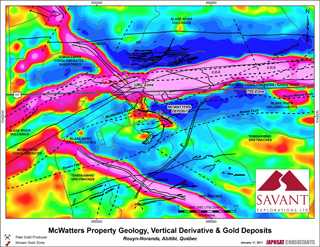
Exploration geophysics is the science of acquiring data regarding the Earth's properties using above ground survey methods. Electromagnetic surveys are used to assess the varying electric currents conducted between sulphide minerals and barren silicate minerals.
Airborne electromagnetic surveys (AEM) offer a fast and cost effective means of acquiring data on electromagnetic currents. Through the use of airborne techniques, it is possible to uncover metallic conductors in difficult to assess areas, such as the discovery of massive sulphides hidden in fresh water or bedrock.
When conducting an electromagnetic survey, it is important to consider the possibility of encountering factors that may interfere with the relay of data. In other words, the following can be considered "geological noise” that will conceal the conductive targets”:
-
Metamorphosed country rock with graphite bands
-
The possible lateral variations that can be found in conductive overburden
-
Serpentinized ultramafics with magnetite bands
-
Existence of clay in rocks or water
The basic principles of conducting an electromagnetic survey are dependent upon an alternating electric current that is passed through a sending coil. A magnetic field is created and when the coil is underground, an eddy current is generated.
As such a second current develops and the electromagnetic field is measured by an electronic amplifier. The closer the receiver and source are to a conductive zone, the eddy current will circulate and intensify, initiating a stronger secondary current.
Although electromagnetic surveys are one of the most cost-efficient surveys to conduct in geophysical exploration, it is vital that each is capable of acquiring the most accurate data possible. As such, data acquisition systems are of vital importance.
A data acquisition system should be capable of responding to faults in shear zones, and graphitic formational conductors. It should also be able to detect variations in overburden conductivity. The more sophisticated the data acquisition system, the more usable and dependable the information gathered will be. Which in turn aids in the development of useful map products.
Electromagnetic surveys are not only employed by mining companies as a means of prospecting for commodities under bedrock. They are also frequently employed as a means of determining whether heavily populated areas are safe to live in with regards to the presence of electromagnetic fields, high instances of radioactivity and faults in regional power systems.